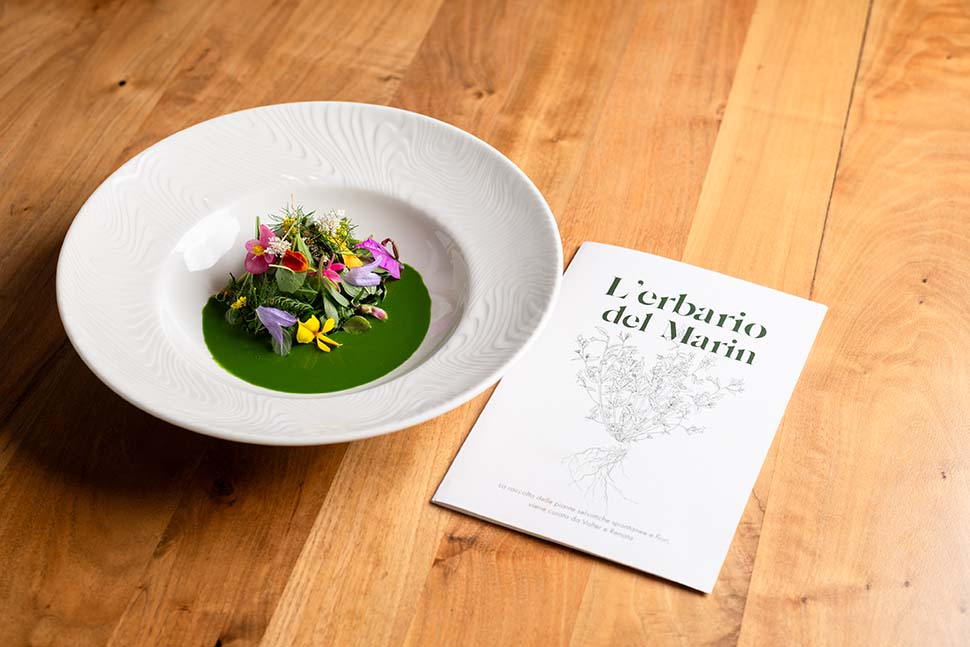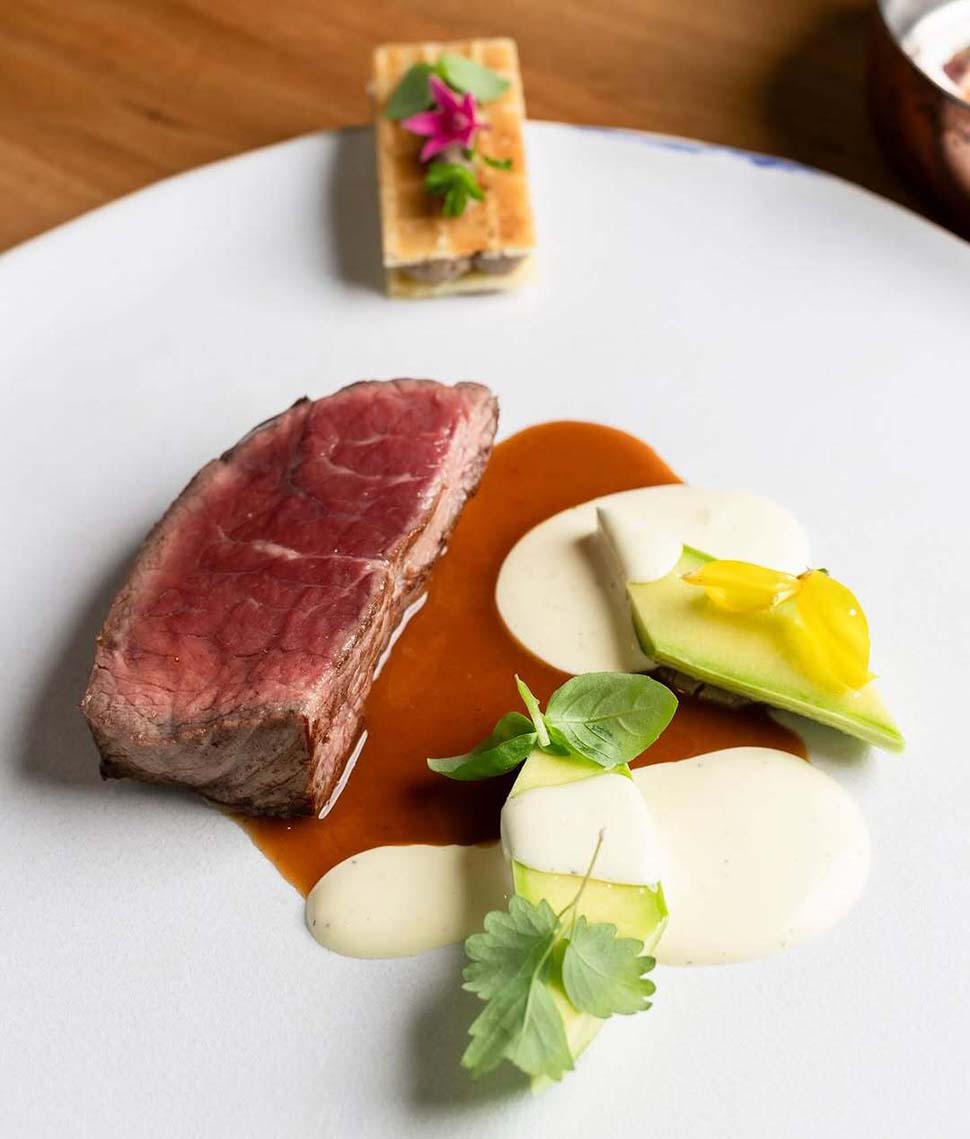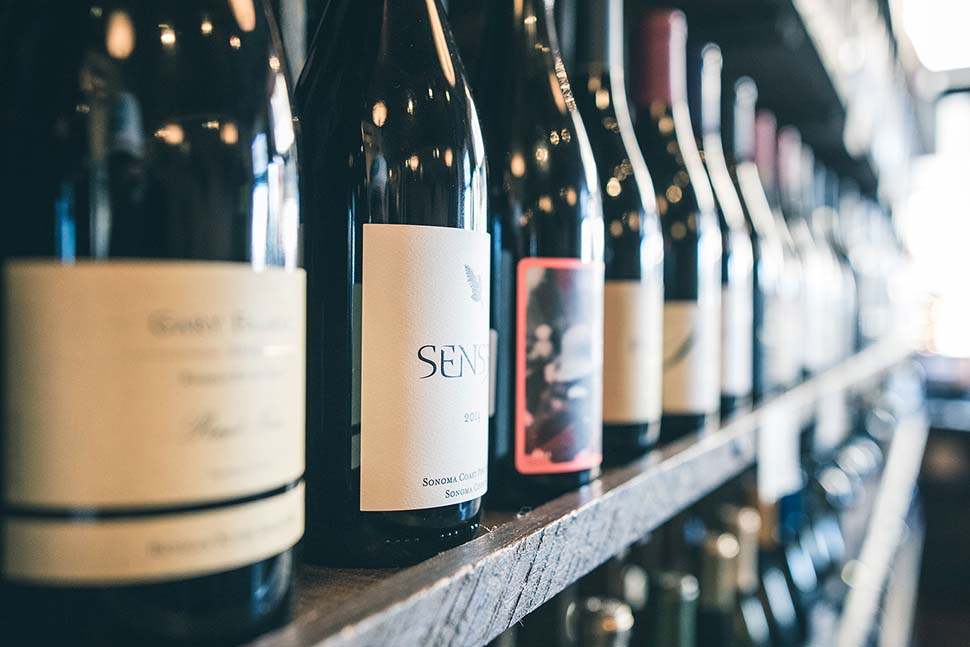Marco Visciola, at the helm of the starred restaurant Il Marin-adjacent to Genoa's Porto Antico-turns cooking into an act of respect for the sea and the entire Ligurian territory. Each of his dishes is born out of a balance between creativity and responsibility, confirmation of an unwavering commitment to a model of conscious dining that pays close attention to the environment, people and economic capital.
Cover photo credits: Ilaria Murtas
Chef's philosophy
A message with a list of wild herbs collected by Renata in Fegino and one with mushrooms found by Walter in the inland woods. A photo of the night's catch from the fishing boats of the Darsena or the Riviera di Ponente. This is how chef Marco Visciola of Il Marin restaurant, a Michelin star at Genoa's Porto Antico, often begins his day.

Perhaps, if it is late fall, he chooses anglerfish, some hake and some mullet, because that and no more is what the Ligurian Sea season offers. He also asks for a moray eel and ospreys, neglected by many cuisines and therefore particularly accessible. He has bunches of pimpinella, barberry, and nasturtium brought in, wisely dosing them for bitterness, combining colors, harmonizing scents. He receives and works drumsticks, trumpets of the dead and chanterelles with which to compose games of shapes, textures, aromas. Before every line, every day, at Il Marin there is the knowledge that the menus may differ in some detail, in some balance and that, for that very reason, they will always faithfully reflect the season (perhaps the essence?) of Liguria.

The menu I am about to recount was that of a mid-November lunch, but as the year progresses, the dishes transform, following the rhythm of nature in accordance with what the territory offers. What never changes is the intent: to express all the personality of the region, sometimes more enigmatic, sometimes more sunny, in the dish.

And it does not change, above all, the philosophy behind it: all-round sustainability, environmental, economic and human. As a good Ligurian in my turn, I know how wild herbs find not only dignity, but true centrality in local dishes. Whether because, traditionally, it is a poor cuisine, or because of the hills and mountains that easily break into the city, it is a bit wild. Without bothering his majesty pesto, which transforms a Pra' herb into a territorial symbol, borage, prebuggiun and other green bouquets can be found on market stalls and in many of the most beloved local dishes: savory pies and stuffed pastas above all.

That's why Chef Visciola's gastronomic tale of Liguria may well linger on the wild vegetable, and then travel and embrace the forms of the Ligurian Sea and rise to identity. It is a tale that comes through the dishes, true, but also through the caressing eloquence of the dining duo, with the expert guidance of Benedetta Canovi, and that becomes tangible in a small paper herbarium as an illustrated compendium provided at the table, almost a legend for diners.


The scene also contributes to the narrative: the Il Marin dining room, with its understated elegance within a space designed by Genoese archistar Renzo Piano, overlooks the sea, as if in dialogue with the open kitchen, and exhibits a restrained but lush aeroponic self-production of herbs. “A vegetable garden suspended over the sea,” one might venture, which is then the definition chef Visciola likes to give of Liguria itself.
The dishes
Three tasting courses are offered:
- CLASSICS, representing the history of the restaurant, with signatures such as the famous “Spaghetti Martini cocktail and caviar”, shaken at the time of service.
- MAREE, dedicated to the sea in all its expressions, fish and vegetable.
- DNA LIGURE, free-handed by the chef, served throughout the table.
One can choose à la carte, or combine the first two menus to compose one to suit one's taste. The flexibility that Il Marin reserves is a joy for those who like to choose. Together with the affordable price for a restaurant of its level, it invites one to return and return.

As a welcome, some of Marin's most iconic dishes arrive at the table as entrées: a miscellany of colors, shapes and concepts. The tortello di pesto al tovagliolo, with its creamy filling that explodes on the palate with elegance, shows the direction of the meal from the first bite, from the first gesture. Cappon magro 2.0 stays the course: the pivotal dish of the Genoese tradition takes on the guise of a minute garden and amazes by combining raw fish with the delicate pungency of fermented vegetables as in South Korea, where Visciola worked for some time early in his career.

Bite after bite, the pinnacle of savoriness is reached through seafood charcuterie, with seasonings ranging from two weeks to three months: cuttlefish lard, amberjack prosciutto, bluefin tuna ventresca, and ombrine, accompanied by red cabbage giardiniera and spaghetti seaweed.

The fish pork is entirely self-produced by the chef, who has been equipped with a Pesciugatore® cell for pH-controlled fish maturation since 2019, when both the idea and the practice were still pioneering. His research that is not limited to the exploration of unexpected tastes and textures, but goes in the direction of giving dignity to every part of the fish, while multiplying its durability and possible uses.

Whether it is to enhance the value of their gardens and suppliers, or to give voice to the vegetable component of their own territory, or because the road well trodden by Enrico Crippa has led the way, it often happens that restaurants propose asignature salad. Marin doesn't shy away from showing its own: wild and spontaneous herbs, mushrooms in oil and raw, ice cream with seasoned prescinsêua, porcini mushrooms, and closing with goat kefir with herbs. Liguria is here, loud and clear.

There is consistency in the following hake, cream of roasted celeriac, marinated turnip and anchovy sauce: two of the fish protagonists in various forms of local cuisine find counterpoint in the earthy notes of inland vegetables. If the grilled monkfish liver escalope with its bottom, orange sauce and roasted pak choi picks up the legacy of the enhancement of the fifth quarter and zero waste of the finanziera di mare, Marin's historic dish, it is perhaps rice, moray eel and saffron that best represents what the restaurant wants to be today: there is a complex fish to work with and enhance, therefore avoided by many cuisines, here used in all its parts and combined with the aromatic grace of saffron from Azienda agricola Rosso, a niche production in Davagna, a few miles above Genoa.

Roasted navon cabbage and hazelnut and Rossese bottoms is a dish that has all the gravity of a disused traditional vegetable ennobled to a starring role. There is earth, there is concentration: there is Liguria. There is intensely Genoa, however, in the dish that celebrates some of the historic stores that have been guarding its flavors for generations: tripe from the Vico Casana tripperia, 80% dark chocolate from the Viganotti chocolate shop, and local spices from the Torielli grocery sisters.

With barbecued cabannina and its stock accompanied by hay and mushroom béarnaise, the only meat course on this itinerary, the chef supports the project of Giampaolo Risso, who in Serra Riccò, in the province of Genoa, raises only 40 castrated male steers a year to carry on theancient local breed, a Slow Food presidium. The cattle grow up fed hay and macadamia nuts, the waste from which is processed by a local company into protein flour, again under the banner of zero waste. The pumpkin, tangerine and hazelnut dessert goes to close the tasting with all the creaminess of autumn and fun crunchy moments.
The Cellar
As for the wine list, territory calls territory, therefore, inevitable that an identity menu such as Marin's gives rise to awide choice of wines from the whole of Liguria, from vermentini to rossesi.

There is no shortage of representations of classic Italian oenology, and there are a few forays among unconventional or international productions, from France to Napa Valley. Particularly centered is the proposal of Derthona 2022 from Vigneti Massa: a classic that never disappoints and accompanies equally complex dishes with its rich minerality.
Conclusion
Il Marin's brigade stands out for its harmony, freshness and attractiveness. The restaurant is highly coveted for educational experiences by young people from all over the world, and the chef of this knows how to make a virtue out of an international group in which each person brings new ideas, new techniques. Currently, for example, in the kitchen there is a Korean chef and a pastry chef from Argentina, who proposed herself by sending in her thesis on desserts from the sea.

I have been frequenting Marco Visciola's ventures at Il Marin since its inception, when in 2015 he inherited what was then considered Eataly Genova's excellent seafood restaurant. Today it is owned by the chef himself, who has evolved it to the point of crowning his efforts with a Michelin star earned in 2023 and retained again this year.

Born in 1985 in Bogliasco, a village on the eastern Ligurian Riviera, over the years Visciola has become an esteemed reference for anyone in town who loves fine dining, thanks to his placid, serious and creative work. He has vision and courage both in the kitchen and as an entrepreneur. Together with partner Carlo Barile, he gave birth in 2021 to Tenuta Golfo Paradiso with the restaurant Ortica, an evolving project on the heights of Pieve, and he has new activities in the pipeline in the area that it will soon be time to learn about.
Contact
Il Marin
Address: Old Port Millo Building
Calata Cattaneo, 15 - 16126 - Genoa (GE)
Phone: +39 010 8698722
E-mail: info@ilmarin.it











